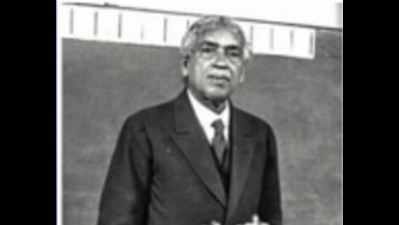- News
- City News
- kolkata News
- Jagadish Bose frequency holds key to 5G tech
Trending
This story is from March 18, 2017
Jagadish Bose frequency holds key to 5G tech
Over a century after Jagadish Chandra Bose invented radio communication but saw Italian inventor Guglielmo Marconi walk away with the credit, he is set to get his due. The millimetre wavelength frequency that Bose used in his experiment in 1895 is the foundation of 5G that scientists and technologists across the world are now trying to reinvent.

Jagadish Chandra Bose.
KOLKATA: Over a century after Jagadish Chandra Bose invented radio communication but saw Italian inventor Guglielmo Marconi walk away with the credit, he is set to get his due. The millimetre wavelength frequency that Bose used in his experiment in 1895 is the foundation of 5G that scientists and technologists across the world are now trying to reinvent.
“I take a lot of inspiration from Bengal and Kolkata because it is here that radio communication was born.The mm wave that J C Bose worked on is the backbone of developing 5G. Marconi and Russian scientists Alexander Stepanovich Popov, who were also conducting similar experiments, were working with much lower frequencies. In fact, the technology that Marconi used was developed by Bose,” said Ramjee Prasad, professor of Future Technologies for Business Ecosystem Innovation, Aarhus University, Denmark, on the sidelines of the IEEE International 5G Summit in Kolkata on Friday.
Institute of Electrical and Electronics Engineers, the largest international technical professional organization for advancement of technology, recognised the 1895 experiment as an IEEE milestone nearly 120 years later. Bose generated electrical radiation at 5mm wave or 60GHz at a time when there were no instruments to measure such frequencies. Further research and development on mm wave was carried out 60 years later. Frequency spectrum extends from voice frequ-ency signals to visible light and beyond. Millimetre waves are a small part of the frequency spectrum.
“In the scientific community, Bose is now gaining recognition as the father of radio science and semiconductors technology. His experiments in early 1890s and early 1900s with mm wave radio frequencies were much ahead of his time — so much so that the time has only come now. While advancement in semiconductor technology led to smartphones, mm wave communication technology may bring about a more wirelessly connected world tomorrow,” remarked Suvra Sekhar Das, associate professor at the GS Sanyal School of Telecommunication at IIT-Kharagpur.
In 1895, Bose conducted an experiment to demonstrate the generation, transmission and reception of electromagnetic waves at mm wave frequencies at the Town Hall in Kolkata. He ignited gunpowder and rang a bell at a distance using mm waves. In a Bengali essay, ‘Adrishya Alok’, Bose wrote: “The invisible light can easily pass through brick walls, buildings. Therefore, messages can be transmitted without the mediation of wires.”
“Bose was a giant who worked single-handedly at the Presidency College laboratory, overcoming racial discrimination, lack of funding and equipment. Our student resource is still very good. All we need is the right initiative to collaborate with the international scientific community. Bose’s experiment was proof of concept. The application happened much later. Now, both of them have to happen simultaneously,” said Debasish Datta, professor of electronics and electrical communication engineering at IIT-Kharagpur.
“I take a lot of inspiration from Bengal and Kolkata because it is here that radio communication was born.The mm wave that J C Bose worked on is the backbone of developing 5G. Marconi and Russian scientists Alexander Stepanovich Popov, who were also conducting similar experiments, were working with much lower frequencies. In fact, the technology that Marconi used was developed by Bose,” said Ramjee Prasad, professor of Future Technologies for Business Ecosystem Innovation, Aarhus University, Denmark, on the sidelines of the IEEE International 5G Summit in Kolkata on Friday.
Institute of Electrical and Electronics Engineers, the largest international technical professional organization for advancement of technology, recognised the 1895 experiment as an IEEE milestone nearly 120 years later. Bose generated electrical radiation at 5mm wave or 60GHz at a time when there were no instruments to measure such frequencies. Further research and development on mm wave was carried out 60 years later. Frequency spectrum extends from voice frequ-ency signals to visible light and beyond. Millimetre waves are a small part of the frequency spectrum.
“In the scientific community, Bose is now gaining recognition as the father of radio science and semiconductors technology. His experiments in early 1890s and early 1900s with mm wave radio frequencies were much ahead of his time — so much so that the time has only come now. While advancement in semiconductor technology led to smartphones, mm wave communication technology may bring about a more wirelessly connected world tomorrow,” remarked Suvra Sekhar Das, associate professor at the GS Sanyal School of Telecommunication at IIT-Kharagpur.
Many of his original equipment are still in existence at the Bose Institute in Kolkata and can be an inspiration to scientists working on the next generation telecommunication, felt New Jersey-based Ashutosh Dutta, co-chair of the IEEE 5G initiative.
In 1895, Bose conducted an experiment to demonstrate the generation, transmission and reception of electromagnetic waves at mm wave frequencies at the Town Hall in Kolkata. He ignited gunpowder and rang a bell at a distance using mm waves. In a Bengali essay, ‘Adrishya Alok’, Bose wrote: “The invisible light can easily pass through brick walls, buildings. Therefore, messages can be transmitted without the mediation of wires.”
“Bose was a giant who worked single-handedly at the Presidency College laboratory, overcoming racial discrimination, lack of funding and equipment. Our student resource is still very good. All we need is the right initiative to collaborate with the international scientific community. Bose’s experiment was proof of concept. The application happened much later. Now, both of them have to happen simultaneously,” said Debasish Datta, professor of electronics and electrical communication engineering at IIT-Kharagpur.
End of Article
FOLLOW US ON SOCIAL MEDIA










